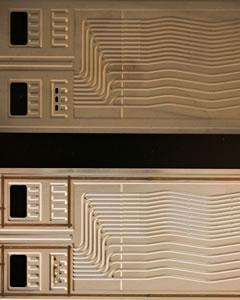
Several years of scientific study followed by assessment and scale-up work that began in 2007 have culminated in researchers establishing the viability of a novel nitriding approach in conjunction with an ORNL-developed ferritic stainless steel alloy for use with thin stamped bipolar plates.
The design basis of the alloy, Fe-20Cr-4V, evolved from studies of protective nitride surface layer formation on more expensive titanium-base and nickel-base alloys, to implementation in low-cost iron-base alloys. Unlike many conventional stainless steels, this ferritic alloy contains vanadium that during thermal treatment aids the formation of a protective nitride coating with properties that support both excellent corrosion resistance and electric conductivity.
“With the unique coating properties, the thin stamped nitrided metallic bipolar plate provides a low-interfacial-contact and corrosion-resistant surface with no observed performance decline attributable to the plates,” said ORNL team leader Mike Brady, Materials Science and Technology Division, summarizing findings from extensive studies of corrosion resistance, electrical properties, and more than 1000 hours of single-cell fuel cell evaluation under cyclic conditions.
In addition to results indicating performance comparable to or better than current technologies, the alloy is much less expensive to manufacture than graphite, a material commonly used to form bipolar plates. Its thinness (less than 0.1 mm) also enables greater overall fuel cell power density.
“Because the plates are so thin compared to graphite, more can be added to the fuel cell stacks for high power density in automotive or other applications,” said Brady. He explained that typically, one hundred or more bipolar plates are employed inside a proton exchange membrane fuel cell stack, the device that chemically converts energy from hydrogen into electricity. Each plate electrically connects the anode of one cell to the cathode of another to produce a useful voltage.
In 2011, General Motors Research Laboratories conducted manufacturing and fuel cell assessments using the ORNL-developed nitrided alloy, further supporting promising properties previously identified by ORNL and others. Using current GM stamping practices and plate design, the nitrided material was manufactured into a state-of-the-art automotive bipo lar plate and found to be amenable to laser welding assembly. Under the GM relative humidity cycling, single-cell fuel cell performance evaluation (500–1000 hours of operation), the nitrided bipolar plates maintained low contact resistance and the proton exchange membrane exhibited only trace levels of metal ion contamination, consistent with good corrosion resistance under fuel cell operating conditions.
Brady is currently working with GM to complete a journal article on the test results, scheduled for publication in early 2012. Other ORNL researchers involved in the project include Energy and Transportation Science Division’s Todd Toops and Josh Pihl, and MSTD’s Peter Tortorelli, Karren More, Harry Meyer, and Phil Maziasz.

